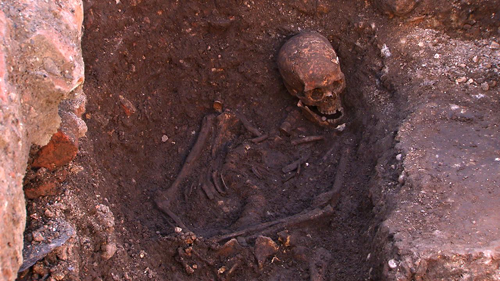Science Fit for the Stage: DNA Sequencing Confirms Identity of Richard III's Skeleton
Archaeologists and scientists have announced that the remains found last summer beneath a Leicester parking lot are those of Richard III, a much-maligned figure from English history. The story offers an enticing mix of history, literature, and science. Curious students, classes, and parents can learn more about genetics and genomics procedures used to solve the puzzle of the skeleton's identity.

Made glorious summer by this sun of York;
And all the clouds that lour'd upon our house
In the deep bosom of the ocean buried."
These famous opening lines were spoken by Shakespeare's Richard III in the play
Richard III was killed in 1485 during the Battle of Bosworth, the final conflict in the War of Roses, a series of battles between the houses of Lancaster and York for the throne of England. With Richard's death, Henry VII ascended to the throne and began rule by the Tudors, a ruling dynasty that continued for more than one hundred years. Historical account of what happened to Richard III after his death is vague. Some maintained his remains had been buried near a local church, but as the years passed, the original location of the Greyfriars Friary was lost.
The lack of concrete knowledge regarding the fallen king's burial fed an aura of mystery regarding Richard's remains, a mystery that has intrigued historians for years and a puzzle that a team of scientists and archaeologists from the University of Leicester undertook to solve.
Digging into History
Last August, the remains of a body were found in Leicester, England by a team led by archaeologist Richard Buckley. Having determined the location, they thought, of the original Greyfriars Friary, a parking lot now, Buckley and team began to dig. They turned up "a human skeleton, complete with evidence of battle wounds—a blow to the head, and an arrow in the back—and scoliosis, or curvature of the spine."
Radiocarbon dating of the skeleton confirmed that the individual died in the second half of the 15th or in the early 16th century, which fits with Richard's death in 1485. The age of the individual at the time of death was posited as late 20s or early 30s. Richard died at 32. These results offered early indication that the remains might be the ones for which the team had been searching and fueled the quest for irrefutable identification. Characteristics of the skeleton, including the scoliosis and evidence of a fatal blow to the head further appeared to corroborate the story. But many people died in the late 1400s. Determining, without a doubt, the identity of the skeleton required more comprehensive and sophisticated research and science.
After many months of scientific inquiry, the identity of the remains has now been announced as conclusively belonging to the oft-maligned king. The announcement has left many intrigued. More than 500 years have passed, but a number of clues and the results of many scientific procedures, including mitochondrial DNA sequencing and radiocarbon dating, all go together to tell a unified story: the skeleton is that of Richard III.
The Thrill of Science
For young scientists, the story of Richard's exhumation and discovery is one that combines the best of history, adventure, mystery, and science. In a fitting twist, this week's science news tells a tale worthy of the stage. But in the end, science held the key to the identification of the skeleton. As detailed on the University of Leicester's The Search for Richard III site devoted to the excavation and identification, the many stages of scientific research and analysis included DNA extraction, X-ray tomography, osteology, and carbon dating.
Students fascinated by the story can conduct their own genetics and genomics science explorations to learn more about the processes scientists used to solve the puzzle of the skeleton's identity. The following Project Ideas guide students in hands-on research working with BLAST and building evolutionary trees using mitochondrial sequences:
- "Neanderthals, Orangutans, Lemurs, & You--It's a Primate Family Reunion!"
- "Trace Your Ancient Ancestry Through DNA"
- "What is the Woolly Mammoth's Closest Living Relative?
- "Use DNA Sequencing to Trace the Blue Whale's Evolutionary Tree"
Stay tuned! A new Project Idea is coming to Science Buddies that will give students a chance to simulate radiocarbon dating.
Further Reading
- University of Leicester announces discovery of King Richard III
- The Search for Richard III
- Discovery of Remains of England's King Richard III Confirmed
- Skeletal sleuthing team uncovered royal remains and the story behind them
- Body found under parking lot is King Richard III, scientists prove
- Bones Under Parking Lot Belonged to Richard III
Categories:
You Might Also Enjoy These Related Posts:
- Plastics and Earth Day - Science Projects
- Arduino Science Projects and Physical Computing
- 10+ Robotics Projects with the BlueBot Kit
- 5 STEM Activities with Marshmallow Peeps
- March Madness Basketball Science Projects: Sports Science Experiments
- Women in STEM! More than 60 Scientists and Engineers for Women's History Month
- Explore Artificial Intelligence and Machine Learning with Student AI Projects
- 10 Reasons to Do the Rubber Band Car Engineering Challenge















